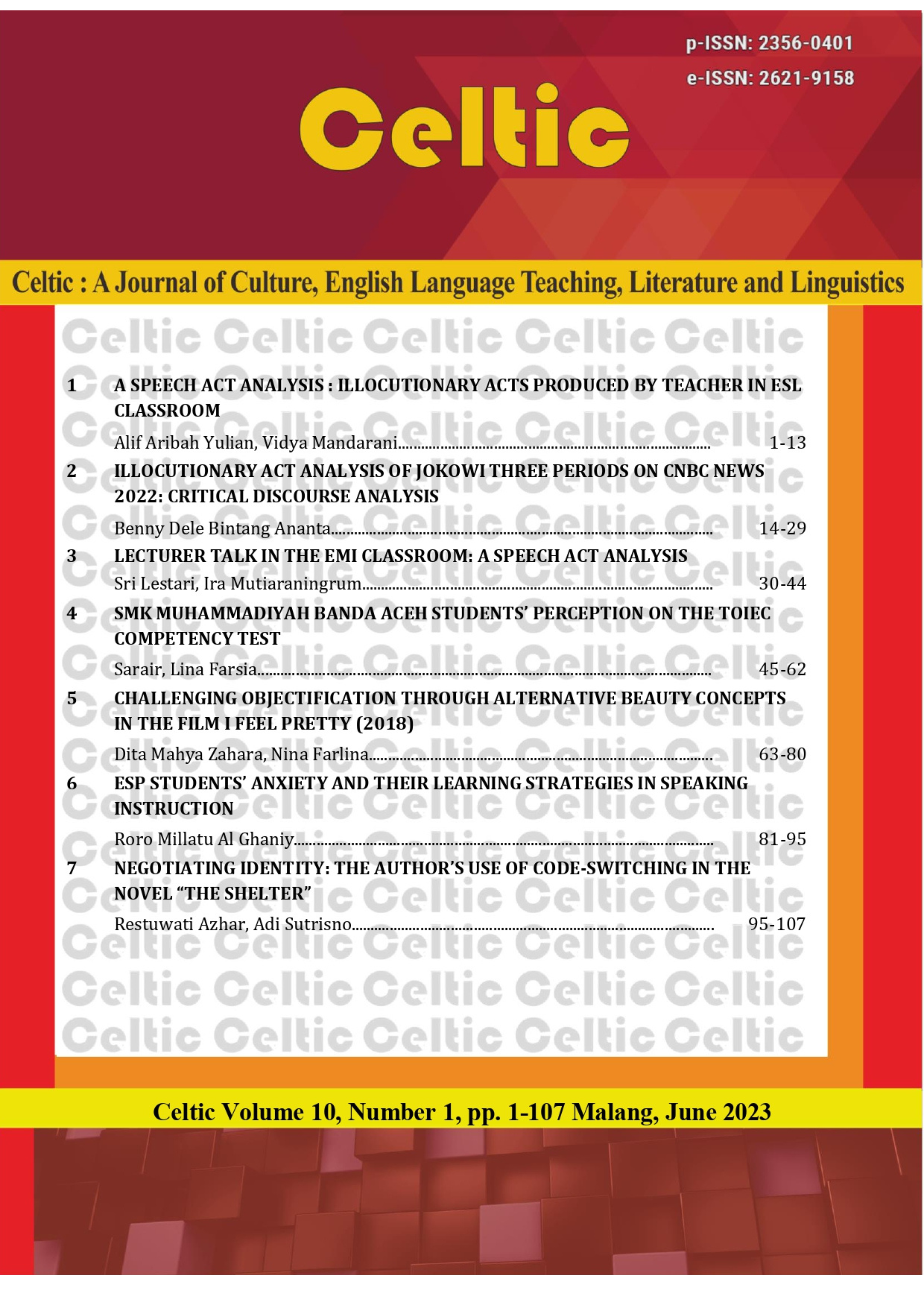LECTURER TALK IN THE EMI CLASSROOM: A SPEECH ACT ANALYSIS
DOI:
https://doi.org/10.22219/celtic.v10i1.25365Abstract
Research in the area of utilizing English as a medium of instruction has
overlooked the investigation of communication issues among lecturers
teaching their disciplines in English. This study seeks to determine the most
common speech act employed by lecturers utilizing English as a medium of
instruction, the rationale behind the selection, and its implication on
pedagogy and education. Employing a case study, we recruited four
instructors from Biology and Primary Education who teach content-based
subjects in English. With Searle's framework of speech acts, the study
revealed that assertive speech acts were used 42.85%, directive 25.8%,
expressive 21.65%, and commissive 9.6%. The findings indicate that most
lecturers used assertive speech acts to clarify content and engage students
in achieving learning objectives. This study expected to give contribution
as reflection tool on how speech acts should be performed in teaching
process to promote successful English utilization by instructors teaching
non-English subjects.
Downloads
References
Al Hakim, M. A. (2021). Revealing the Potential Impacts of English-Medium Instruction (EMI) in Indonesian Higher Education Context. IDEAS: Journal on English Language Teaching and Learning, Linguistics and Literature, 9(2), 461-472. http://dx.doi.org/10.24256/ideas.v9i2.2343
An, J., Macaro, E., & Childs, A. (2021). Classroom interaction in EMI high schools: Do teachers who are native speakers of English make a difference?. System, 98, 102482. https://doi.org/10.1016/j.system.2021.102482
Arani, S. S. (2012). A study of directive speech acts used by Iranian nursery school children: The impact of context on children’s linguistic choices. International Journal of Applied Linguistics and English Literature, 1(5), 163-175. http://dx.doi.org/10.7575/ijalel.v.1n.5p.163
Basra, S., & Thoyyibah, L. (2017). A speech act analysis of teacher talk in an EFL classroom. International Journal of Education, 10(1), 73-81. http://dx.doi.org/10.17509/ije.v10i1.6848
Beijer, F. (2003). The pragmatics of exclamations and other expressive emotional utterances. Stockholm, Sweden: University of Yarnn. http://www.englund.lu.se/research/workingpapers/pdf-volume2/Fabian.pdf
Celce-Murcia, M., & Olshtain, E. (2000). Discourse and context in language teaching: A guide for language teachers. Cambridge University Press.
Chou, M. H. (2018). Speaking anxiety and strategy use for learning English as a foreign language in full and partial English‐medium instruction contexts. Tesol Quarterly, 52(3), 611-633. https://eric.ed.gov/?id=EJ1192045
Cklopaking, N. (2020). AN ANALYSIS OF DIRECTIVE SPEECH ACT PERFORMED BY ENGLISH DEPARTMENT LECTURERS OF NOMMENSEN HKBP UNIVERSITY.
Council, B. (2021). The state of English as medium of instruction (EMI) in higher education institutions in Indonesia. British Council.
Creswell, J. W. (2002). Educational research: Planning, conducting, and evaluating quantitative (Vol. 7). Prentice Hall Upper Saddle River.
Dawson, H., & Phelan, M. (2016). Language files: Materials for an introduction to language and linguistics. The Ohio State University Press.
Dearden, J. (2014). English as a medium of instruction-a growing global phenomenon. British Council..
Dimova, S., & Kling, J. (2018). Assessing English‐medium instruction lecturer language proficiency across disciplines. Tesol QUARTERLY, 52(3), 634-656. https://www.jstor.org/stable/44987084
Evertson, C. M., & Weinstein, C. S. (Eds.). (2013). Handbook of classroom management: Research, practice, and contemporary issues. Routledge.
Goh, C., & Foong, K. P. (1997). Chinese ESL students’ learning strategies: A look at frequency, proficiency, and gender. Hong Kong Journal of Applied Linguistics, 2(1), 39-53.
Helm, F., & Guarda, M. (2015). “Improvisation is not allowed in a second language”: A survey of Italian lecturers’ concerns about teaching their subjects through English. Language Learning in Higher Education, 5(2), 353-373. https://doi.org/10.1515/cercles-2015-0017
Hu, G., & Lei, J. (2014). English-medium instruction in Chinese higher education: A case study. Higher Education, 67, 551-567. https://doi.org/10.1007/s10734-013-9661-5
Huberman, M., & Miles, M. B. (2002). The qualitative researcher's companion. Sage.
Hutajulu, F. S. L., & Herman, H. (2019). Analysis of illocutionary act in the movie “You Are My Home” English subtitle. Journal of English Educational Study (JEES), 2(1), 29-36. https://doi.org/10.31932/jees.v2i1.371
Idris, A. M. S., Gusnawaty, G., Hasjim, M., & Kamsinah, K. The lecturers and students’ speech act used in classroom interaction: A case study. HUMANIKA, 30(1), 91-103.
Jensen, C., & Thøgersen, J. (2011). Danish university lecturers' attitudes towards English as the medium of instruction. Ibérica, Revista de la Asociación Europea de Lenguas para Fines Específicos, (22), 13-33. https://www.redalyc.org/pdf/2870/287023888002.pdf
Jin, L., & Cortazzi, M. (2008). Images of teachers, learning and questioning in Chinese cultures of learning. Metaphors for learning: Cross-cultural perspectives, 177-202. https://wrap.warwick.ac.uk/47969/
Johnson, J. H., & Picciuolo, M. (2020). Interaction in spoken academic discourse in an EMI context: The use of questions. International Conference on Higher Education Advances, 2020-June, 211–219. https://doi.org/10.4995/HEAd20.2020.11018
Llurda, E. (2005). Non-native language teachers: Perceptions, challenges and contributions to the profession (Vol. 5). Springer Science & Business Media.
Lo, Y. Y., & Macaro, E. (2012). The medium of instruction and classroom interaction: Evidence from Hong Kong secondary schools. International Journal of Bilingual Education and Bilingualism, 15(1), 29-52.
Macaro E (2018). English Medium Instruction. Oxford University Press.
Marzano, R. J., & Marzano, J. S. (2003). The key to classroom management. Educational leadership, 61(1), 6-13. https://college.cengage.com/education/ryan_cooper/kaleidoscope/11e/prepare/ryan_kal_11e_featured_part5.pdf
Muttaqin, S. (2020). Higher Education Internationalization: A Brief Look at International Classes and English Medium Instruction (EMI) Policy at Universities in Indonesia. In The Proceedings of The 37th International Conference on English Teaching and Learning & The 22nd International Conference and Workshop on TESL & Applied Linguistics (p. 81).
Novitasari, N., Wahyuningsih, N., & Agustina, H. N. (2022). Improving students’speaking skills through CLIL in tourist guiding online class. Celtic: A Journal of Culture, English Language Teaching, Literature and Linguistics, 9(1), 53-68. https://doi.org/10.22219/celtic.v9i1.20903
Nurani, N. P. (2015). A pragmatic analysis of classroom speech acts in the English teaching and learning process at SMA N 1 Purworejo (A Case Study). (Unpublished Thesis). Yogyakarta State University, Indonesia
Qadir, A., & Riloff, E. (2011, July). Classifying sentences as speech acts in message board posts. In Proceedings of the 2011 Conference on Empirical Methods in Natural Language Processing (pp. 748-758). https://aclanthology.org/D11-1069.pdf
Ratnawati, R., & Romansyah, R. (2022). Analyzing EFL classroom interaction in contextual teaching and learning among class members. Celtic: A Journal of Culture, English Language Teaching, Literature and Linguistics, 9(2). https://doi.org/10.22219/celtic.v9i2.22823
Santosa, A. W., & Kurniadi, A. (2020). Speech act analysis of teacher talk in EFL classroom. Jurnal Penelitian Humaniora, 21(2), 101–107. https://doi.org/10.23917/humaniora.v21i2.9871
Sari, D. K., Chandra, N. E., & Al Arief, Y. (2021, October). An analysis of illocutionary acts produced by the lecturer in online classroom interaction. In 2nd International Conference on Education, Language, Literature, and Arts (ICELLA 2021) (pp. 58-62). Atlantis Press.
Searle, J. R. (1976). A classification of illocutionary acts1. Language in society, 5(1), 1-23. http://www.jstor.org/stable/4166848?origin=JSTOR-pdf
Sercu, L. (2004). The introduction of English-medium instruction in universities: A comparison of Flemish lecturers' and students' language skills, perceptions and attitudes. In Integrating content and language: meeting the challenge of a multilingual higher education: proceedings of the ICL conferenc, October 23-25 2003/Ed. by Robert Wilkinson.-Maastricht: Maastricht university press (pp. 547-555).
Setoningsih, D. A. (2021). Students’and teachers’perspectives on EMI (English medium of instruction) at Thursina IIBS Malang (Doctoral dissertation, Universitas Muhammadiyah Malang).
Simbolon, N. E. (2021). English Medium Instruction (EMI) practice: higher education internationalization in Indonesia. Englisia: Journal of Language, Education, and Humanities, 8(2), 72-83. http://dx.doi.org/10.22373/ej.v8i2.8961
Simbolon, N. E. (2023). English Medium Instruction (EMI) in Higher Education: Insights from Indonesian Vocational Lecturers. Utamax: Journal of Ultimate Research and Trends in Education, 5(1), 11-20. https://doi.org/10.31849/utamax.v5i1.9973
Sundusiyah, A. (2023). A Case of English as Medium of Instruction in Indonesia. Education and Power in Contemporary Southeast Asia, 93.
Talaue, F. G., & Kim, M. K. (2020). Investigating the advantages of english medium instruction (EMI) in the indonesian workplace. LEARN Journal: Language Education and Acquisition Research Network, 13(2), 321-334. https://files.eric.ed.gov/fulltext/EJ1258794.pdf
Utami, L. P., & Sulistyaningrum, S. D. (2022). The incorporation of communication skills in public speaking course syllabus at English language education study program. Celtic: A Journal of Culture, English Language Teaching, Literature and Linguistics, 9(1), 1-20. https://doi.org/10.22219/celtic.v9i1.18281
Vinke, A. A., Snippe, J., & Jochems, W. (1998). English‐medium Content Courses in Non‐English Higher Education: a study of lecturer experiences and teaching behaviours. Teaching in Higher Education, 3(3), 383-394. https://doi.org/10.1080/1356215980030307
Waloyo, E., Lestari, S., & Mutiaraningrum, I. (2023). Exploring Studies on Cooperative Principle in English Language Teaching: A Literature Review. Metathesis: Journal of English Language, Literature, and Teaching, 7(1), 17-30. https://doi.org/10.31002/metathesis.v7i1.157
Yule, G., & Widdowson, H. G. (1996). Pragmatics. Oxford university press.
ThoughtCo. (2019). Speech Act Theory. Retreieved from https://www.thoughtco.com/speech-act-theory-1691986
Yin, R. K. (2018). Case Study Research & applications: Design and methods (Sixth edition). Thousand Oaks.
Downloads
Published
How to Cite
Issue
Section
License
Copyright (c) 2023 Sri Lestari, Ira Mutiaraningrum

This work is licensed under a Creative Commons Attribution-ShareAlike 4.0 International License.
- Authors retain copyright to publish without restrictions and grant the journal right of first publication with the work simultaneously licensed under a Creative Commons Attribution License that allows others to share the work with an acknowledgement of the work's authorship and initial publication in this journal.
- Authors are able to enter into separate, additional contractual arrangements for the non-exclusive distribution of the journal's published version of the work (e.g., post it to an institutional repository or publish it in a book), with an acknowledgement of its initial publication in this journal.
- Authors are permitted and encouraged to post their work online (e.g., in institutional repositories or on their website) prior to and during the submission process, as it can lead to productive exchanges, as well as earlier and greater citation of published work.














